
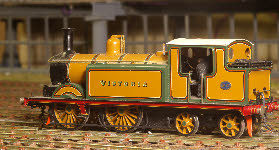


Updated February 2021
I2 No 13
I3 No 22
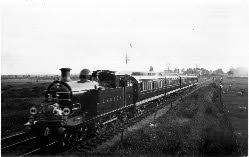 The rather sorry tale of Marsh’s attempts to build an efficient Atlantic tank to replace the ageing Stroudley express passenger engines is told on the I3 page. The I2 tanks were nevertheless rather handsome, not withstanding their poor performance. We are currently building a Smokey Locos Royal Train (which has been in my ‘to-
The rather sorry tale of Marsh’s attempts to build an efficient Atlantic tank to replace the ageing Stroudley express passenger engines is told on the I3 page. The I2 tanks were nevertheless rather handsome, not withstanding their poor performance. We are currently building a Smokey Locos Royal Train (which has been in my ‘to-do’ box for over 25 years) and there are several photos of I2 no 15 hauling this train. There are no kits available for an I2, so I’m back to my favourite element of railway modelling - scratchbuilding a locomotive.
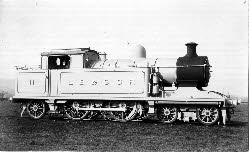
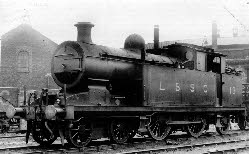 Rather than build no 15, I’ve chosen to model no 13, which had a slightly more interesting history. It was involved in the 1915 accident at Streatham. It was also one of the last in service, withdrawn in 1939. It wasn’t scrapped, and was subsequently used as a temporary bomb shelter at Portsmouth -
Rather than build no 15, I’ve chosen to model no 13, which had a slightly more interesting history. It was involved in the 1915 accident at Streatham. It was also one of the last in service, withdrawn in 1939. It wasn’t scrapped, and was subsequently used as a temporary bomb shelter at Portsmouth - parked over a pit and covered in sandbags. There are several photos of no 13 in various states - the original with bogie brakes and sanding gear fore and aft of both drivers (photo left), and later around the grouping fitted with vacuum ejectors as well as the Westinghouse air brakes (photo right).
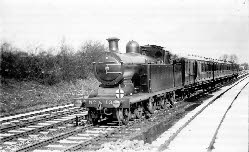 No 13 has been built in its intermediate appearance as in the photo (right), but with ‘LBSC’ lettering rather than ‘LB&SCR’.
No 13 has been built in its intermediate appearance as in the photo (right), but with ‘LBSC’ lettering rather than ‘LB&SCR’.
I’ve based the chassis design on my I3, which has performed successfully for over a quarter of a century. The I3 used a Portescap motor/gearbox, but for the I2 I’ve used a High Level Models ‘Roadrunner+’ gearbox with a ‘drive-stretcher’ to extend the gear train under the cab, to drive on the rear coupled wheels. The chassis is fully compensated with side beams between the rear coupled wheels and the radial axle box. There is a central beam between the leading coupled axle and the bogie pivot. The bogie frames can pivot about a vertical axis and move up or down relative to the main frames (supported by the central beam) and the axles are fully compensated within the bogie frame. The only differences compared with the I3 are the absence of a centring spring on the radial axle box, and the simplification of the bogie which cannot move from side to side in the I2. Both of these have been found to be unnecessary complication on the I3. Horizontal flexibility is provided by allowing the leading coupled axle to move side to side, and by the radial axle box. On test this engine can easily run through a B7 turnout (the tightest on Plumpton Green).
Pick up is via the split axles on coupled wheels.
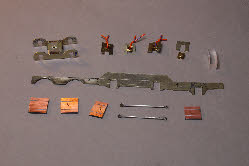
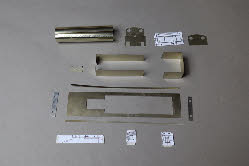 The photo on the left shows the main body components cut out, ready to assemble, and the photo (right) shows the chassis components.
The photo on the left shows the main body components cut out, ready to assemble, and the photo (right) shows the chassis components.
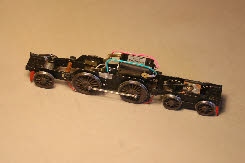
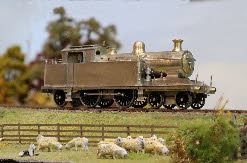 The photo (left) shows the finished chassis and (right) the loco part finished, ready for painting.
The photo (left) shows the finished chassis and (right) the loco part finished, ready for painting.
The photo below left shows no 13 finished and running on Plumpton Green, and on the right, my first scratch built engine (1978) Terrier no 678, and the latest (2021).
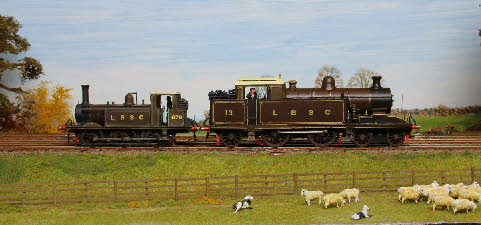
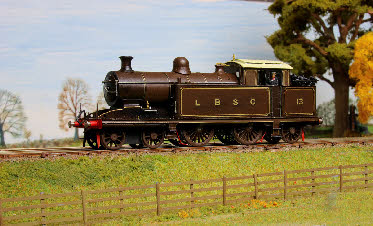
I2 No 13
I3 No 22
 The rather sorry tale of Marsh’s attempts to build an efficient Atlantic tank to replace the ageing Stroudley express passenger engines is told on the I3 page. The I2 tanks were nevertheless rather handsome, not withstanding their poor performance. We are currently building a Smokey Locos Royal Train (which has been in my ‘to-
The rather sorry tale of Marsh’s attempts to build an efficient Atlantic tank to replace the ageing Stroudley express passenger engines is told on the I3 page. The I2 tanks were nevertheless rather handsome, not withstanding their poor performance. We are currently building a Smokey Locos Royal Train (which has been in my ‘to-
 Rather than build no 15, I’ve chosen to model no 13, which had a slightly more interesting history. It was involved in the 1915 accident at Streatham. It was also one of the last in service, withdrawn in 1939. It wasn’t scrapped, and was subsequently used as a temporary bomb shelter at Portsmouth -
Rather than build no 15, I’ve chosen to model no 13, which had a slightly more interesting history. It was involved in the 1915 accident at Streatham. It was also one of the last in service, withdrawn in 1939. It wasn’t scrapped, and was subsequently used as a temporary bomb shelter at Portsmouth - No 13 has been built in its intermediate appearance as in the photo (right), but with ‘LBSC’ lettering rather than ‘LB&SCR’.
No 13 has been built in its intermediate appearance as in the photo (right), but with ‘LBSC’ lettering rather than ‘LB&SCR’.I’ve based the chassis design on my I3, which has performed successfully for over a quarter of a century. The I3 used a Portescap motor/gearbox, but for the I2 I’ve used a High Level Models ‘Roadrunner+’ gearbox with a ‘drive-
Pick up is via the split axles on coupled wheels.

 The photo on the left shows the main body components cut out, ready to assemble, and the photo (right) shows the chassis components.
The photo on the left shows the main body components cut out, ready to assemble, and the photo (right) shows the chassis components.
 The photo (left) shows the finished chassis and (right) the loco part finished, ready for painting.
The photo (left) shows the finished chassis and (right) the loco part finished, ready for painting.The photo below left shows no 13 finished and running on Plumpton Green, and on the right, my first scratch built engine (1978) Terrier no 678, and the latest (2021).

